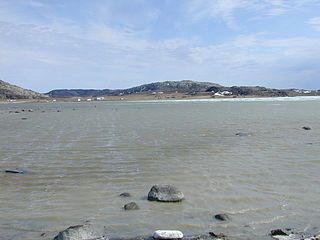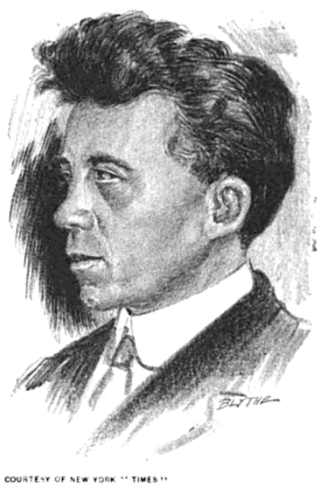
Vilhjalmur Stefansson was an Arctic explorer and ethnologist. He was born in Manitoba, Canada.

The last voyage of the Karluk, flagship of the Canadian Arctic Expedition of 1913–16, ended with the loss of the ship in the Arctic seas, and the subsequent deaths of nearly half her complement of 25.

The Tree River (Kogluktualuk) is a river in Nunavut, Canada. It flows into Coronation Gulf, an arm of the Arctic Ocean.
The Duke of York Archipelago is an uninhabited island group in the Kitikmeot Region, Nunavut, Canada. It is located in the Coronation Gulf.

Copper Inuit, also known as Inuinnait and Kitlinermiut, are a Canadian Inuit group who live north of the tree line, in what is now the Kitikmeot Region of Nunavut and in the Inuvialuit Settlement Region in the Inuvik Region of the Northwest Territories. Most of them historically lived in the area around Coronation Gulf, on Victoria Island, and southern Banks Island.
Ogden Bay is an Arctic waterway in the Kitikmeot Region, Nunavut, Canada. It is located in the southern Queen Maud Gulf off Nunavut's mainland. Chester Bay is situated 32 km (20 mi) to the west, Armark is to the east, and the Keith Islands are to the north.
The Rae River (Pallirk) is a waterway that flows from Akuliakattak Lake into Richardson Bay, Coronation Gulf. Its mouth is situated northwest of Kugluktuk, Nunavut. Its shores were the ancestral home of Copper Inuit subgroups: the Kanianermiut and the Pallirmiut.

Kiillinnguyaq, formerly the Kent Peninsula, is a large Arctic peninsula, almost totally surrounded by water, in the Kitikmeot Region of Nunavut. Were it not for a 8.0 km (5 mi) isthmus at the southeast corner it would be a long island parallel to the coast. From the isthmus it extends 169 km (105 mi) westward into the Coronation Gulf. To the south, Melville Sound separates it from the mainland. To the north is Dease Strait and then Victoria Island. To the west is Coronation Gulf and to the east, Queen Maud Gulf. Cape Flinders marks the western tip of the peninsula, Cape Franklin is at the northwestern point, and Hiiqtinniq, formerly Cape Alexander marks the northeastern point.
Albert Edward Bay is a bay on the southeast side of Victoria Island in the Arctic Archipelago. It faces Victoria Strait to the east. There are several islands in the bay, the largest of which is Admiralty Island at its mouth. Its north side is the Collinson Peninsula.
Ahiagmiut were a geographically defined Copper Inuit subgroup in the northern Canadian territory of Nunavut. They were located near Ogden Bay, on the Queen Maud Gulf, and inland towards Back River, then on towards the Akilinik River.
Akuliakattagmiut were a geographically defined Copper Inuit subgroup in the Canadian territory of Nunavut. They were located near Cape Bexley on the south shore, mainland side of Dolphin and Union Strait, and in the vicinity of the Melville Hills' Akuliakattak Lake, the source of the Rae River.
Haneragmiut were a geographically defined Copper Inuit subgroup in the Canadian territory of Nunavut. They were the most westerly band of those that hunted in southern Victoria Island. They were generally located on the north shore of Dolphin and Union Strait, north of Cape Bexley, and south of Prince Albert Sound, on Victoria Island. Though they migrated seasonally both north and south for hunting, fishing, and trade, they were unaware that Victoria Island was an island.
Sutton Island is located in northern Canada's territory of Nunavut. It is situated in the Dolphin and Union Strait immediately next to Liston Island. Rymer Point and Simpson Bay, on Victoria Island's Wollaston Peninsula are to the northeast. Bernard Harbour, on the mainland, is to the southwest, as is Chantrey Island.
Cape Baring is a Canadian Arctic headland in the Northwest Territories. The most westerly point of the Wollaston Peninsula, it is located on Victoria Island, protruding into the Amundsen Gulf.

The Kangiryuarmiut are an Inuvialuit group, culturally and historically related to the Copper Inuit. They were historically located on Victoria Island in the areas of Prince Albert Sound, Cape Baring, and central Victoria island. They often travelled seasonally around their traditional territory including to Banks Island, both south to Nelson Head and as far north as Mercy Bay to collect raw materials from the wreck of HMS Investigator. Archaeologists have also found many sites left by Kangiryuarmiut and their ancestors in what is now Aulavik National Park. Today, many Kangiryurmiut still live on Victoria Island, in the hamlet of Uluhaktok, now within the Inuvialuit Settlement Region.

The Umingmuktogmiut are a geographically defined Copper Inuit band in the northern Canadian territory of Nunavut, Kitikmeot Region. They were located on the western coast of Kiillinnguyaq, and also further south in eastern Bathurst Inlet around Everitt Point by the Barry Islands. Umingmuktogmiut were notable amongst other Copper Inuit as they had a permanent community, Umingmuktog. They could hunt and fish for Arctic char, Arctic fox, barren-ground caribou, fur seals, and muskox prevalent in the area.
The Ugyuligmiut were a geographically defined Copper Inuit band in the Canadian Arctic's Northwest Territories. They were located on Victoria Island north of Minto Inlet, and on Banks Island in the Aulavik National Park region.
Tahiryuaq, formerly Tahiryuak Lake, is a lake located in the Canadian Arctic's Northwest Territories. It is situated in northcentral Victoria Island, north of Prince Albert Sound, southeast of Minto Inlet.
The Roscoe River is a waterway located above the Arctic Circle on the mainland of Northern Canada.

The Canadian Arctic Expedition 1913–1916 was a scientific expedition in the Arctic Circle organized and led by Vilhjalmur Stefansson. The expedition was originally to be sponsored by the (US) National Geographic Society and the American Museum of Natural History. Canada took over the sponsorship because of the potential for discovery of new land and Stefansson, who though born in Canada was now an American, re-established his Canadian citizenship. The expedition was divided into a Northern Party led by Stefansson, and a Southern Party led by R M. Anderson.








